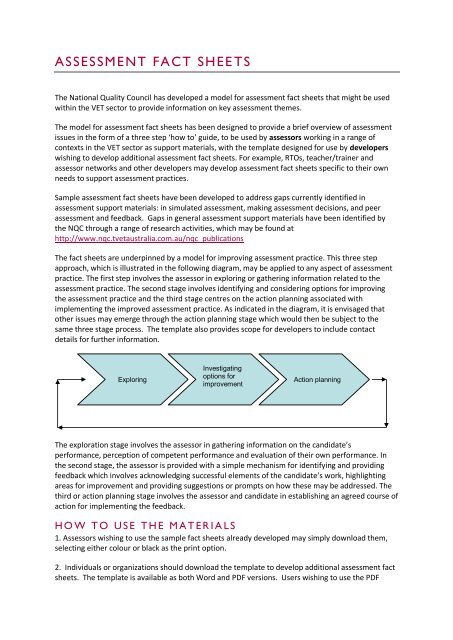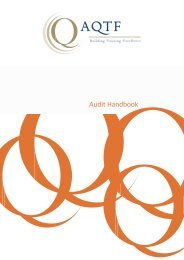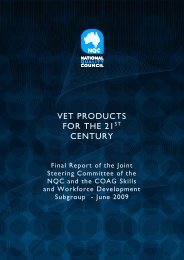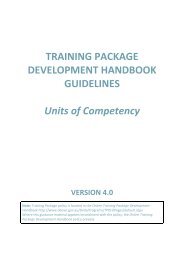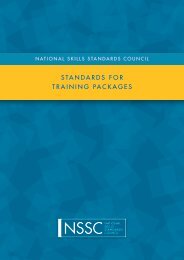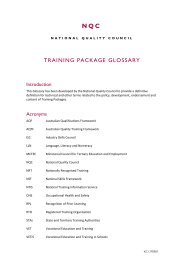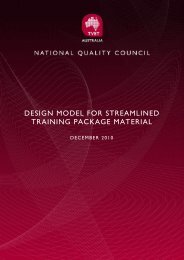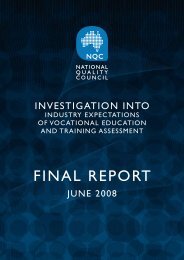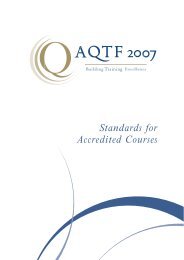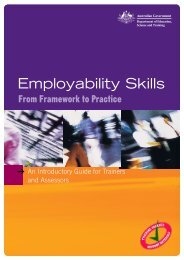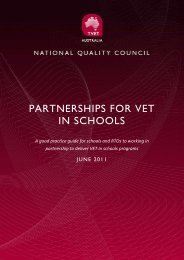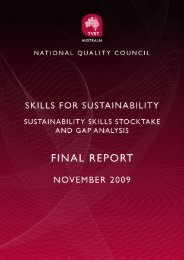Assessment Fact Sheets - Guide - National Skills Standards Council
Assessment Fact Sheets - Guide - National Skills Standards Council
Assessment Fact Sheets - Guide - National Skills Standards Council
Create successful ePaper yourself
Turn your PDF publications into a flip-book with our unique Google optimized e-Paper software.
ASSESSMENT FACT SHEE TS<br />
The <strong>National</strong> Quality <strong>Council</strong> has developed a model for assessment fact sheets that might be used<br />
within the VET sector to provide information on key assessment themes.<br />
The model for assessment fact sheets has been designed to provide a brief overview of assessment<br />
issues in the form of a three step ‘how to’ guide, to be used by assessors working in a range of<br />
contexts in the VET sector as support materials, with the template designed for use by developers<br />
wishing to develop additional assessment fact sheets. For example, RTOs, teacher/trainer and<br />
assessor networks and other developers may develop assessment fact sheets specific to their own<br />
needs to support assessment practices.<br />
Sample assessment fact sheets have been developed to address gaps currently identified in<br />
assessment support materials: in simulated assessment, making assessment decisions, and peer<br />
assessment and feedback. Gaps in general assessment support materials have been identified by<br />
the NQC through a range of research activities, which may be found at<br />
http://www.nqc.tvetaustralia.com.au/nqc_publications<br />
The fact sheets are underpinned by a model for improving assessment practice. This three step<br />
approach, which is illustrated in the following diagram, may be applied to any aspect of assessment<br />
practice. The first step involves the assessor in exploring or gathering information related to the<br />
assessment practice. The second stage involves identifying and considering options for improving<br />
the assessment practice and the third stage centres on the action planning associated with<br />
implementing the improved assessment practice. As indicated in the diagram, it is envisaged that<br />
other issues may emerge through the action planning stage which would then be subject to the<br />
same three stage process. The template also provides scope for developers to include contact<br />
details for further information.<br />
Exploring<br />
Investigating<br />
options for<br />
improvement<br />
Action planning<br />
The exploration stage involves the assessor in gathering information on the candidate’s<br />
performance, perception of competent performance and evaluation of their own performance. In<br />
the second stage, the assessor is provided with a simple mechanism for identifying and providing<br />
feedback which involves acknowledging successful elements of the candidate’s work, highlighting<br />
areas for improvement and providing suggestions or prompts on how these may be addressed. The<br />
third or action planning stage involves the assessor and candidate in establishing an agreed course of<br />
action for implementing the feedback.<br />
H O W T O U S E T H E M A T E R I A L S<br />
1. Assessors wishing to use the sample fact sheets already developed may simply download them,<br />
selecting either colour or black as the print option.<br />
2. Individuals or organizations should download the template to develop additional assessment fact<br />
sheets. The template is available as both Word and PDF versions. Users wishing to use the PDF
version of the template will need to have access to Indesign, a common desk top publishing<br />
program.<br />
C O P Y R I G H T A N D U S E S T A T E M E N T : I M P R O V I N G<br />
A S S E S S M E N T P R A C T I C E F A C T S H E E T S<br />
The Improving <strong>Assessment</strong> Practice fact sheets series was developed by the <strong>National</strong> Quality <strong>Council</strong>.<br />
Commonwealth of Australia 2010.<br />
The Improving <strong>Assessment</strong> Practice fact sheets series is available under an Unlocked Content license<br />
– for details see www.aesharenet.com.au/U4/. This means that the fact sheets may be freely copied,<br />
adapted and used by anyone. Exact copies must retain the owner’s copyright statement and the<br />
AEShareNet-U mark. Enhancements must not contain the owner’s copyright statement and may<br />
have a new copyright statement by the Licensee.<br />
Individuals and organisations wishing to adapt existing or develop new fact sheets may download a<br />
template at http://www.nqc.tvetaustralia.com.au/nqc_publications.
3<br />
• Plan how assessment evidence will be gathered and recorded during<br />
the simulated assessment activity. This may involve developing lists<br />
of things to be observed or questions to asked. Consideration should<br />
also be given to identifying how feedback will be gained from learners<br />
and their employers on the simulated assessment activity.<br />
• Validate the simulated assessment activity with other assessors or<br />
representatives of relevant industry advisory bodies, or professional or in<br />
dustry associations and networks to make sure that it meets current<br />
industry practice and Training Package requirements.<br />
Implement the simulated assessment activity.<br />
• Organise the assessment environment making sure that all required<br />
equipment and materials are available, safe and in working order.<br />
• Actively facilitate the simulated assessment activity. Make sure that the<br />
learners know what they must do and the times allowed for each stage<br />
of the activity.<br />
• Review the effectiveness of the simulated assessment activity and its impact<br />
on learner performance. Make sure that suggestions for improvements are<br />
recorded and incorporated in subsequent versions of the activity.<br />
Improving assessment practice<br />
Improving assessment practice<br />
Improving assessment practice<br />
Simulated<br />
assessment<br />
1
Simulated assessment<br />
Simulation is a form of evidence gathering that involves learnersin<br />
completing or dealing with a task, activity or problem in an<br />
off-the-job situation that reflects the workplace.<br />
Reasons for using<br />
simulated assessment<br />
• <strong>Assessment</strong> can take place even though there is no or<br />
limited access to the workplace.<br />
• Learners have access to equipment, materials and work<br />
tasks that may not be readily available in the workplace.<br />
• <strong>Assessment</strong> is conducted in safe environments.<br />
• Learners may be assessed on unpredictable, potentially<br />
dangerous or infrequently occurring events and situations.<br />
• <strong>Assessment</strong> activities do not disrupt the workplace.<br />
• Learners can repeat assessment tasks and learn from<br />
mistakes without risk.<br />
The three step approach for improving<br />
simulated assessment<br />
1<br />
Find<br />
2<br />
3<br />
out about simulated assessment.<br />
Plan a simulated assessment activity as part of the as<br />
sessment of a unit or a cluster of units of competency.<br />
Implement the simulated assessment activity.<br />
…how to do it.<br />
1 Find out about simulated assessment.<br />
• Read the advice on simulated assessment in the Training Package.<br />
2<br />
• Check whether licensing authorities and industry bodies place conditions<br />
on simulated assessment.<br />
Plan a simulated assessment activity as part of the<br />
assessment of a unit or a cluster of units of competency.<br />
• Think about a situation in which some of the evidence required for<br />
assessment must be gathered through simulation. This may be because<br />
learners do not have access to a real workplace or it is too expensive,<br />
dangerous or disruptive to conduct the assessment in a real workplace.<br />
• Identify a simulated assessment activity that forms part of the assessment<br />
of the relevant unit or cluster of units of competency. This may be a computer<br />
based simulation, a practical demonstration away from the workplace,<br />
a role play or a problem based scenario.<br />
• Design the simulated assessment activity making sure that learners are<br />
required to:<br />
o use actual or simulated equipment and materials which replicate those<br />
found in modern workplaces<br />
o apply current work practices and techniques to produce realistic end<br />
products or services<br />
o meet time pressures and deadlines by placing realistic time constraints on<br />
the activity<br />
o identify risks, follow occupational health and safety procedures and<br />
address questions related to workplace safety as part of the activity<br />
o identify and respond to realistic problems by incorporating contingency<br />
situat ions, such as interruptions to work flow and delays in the supply<br />
of materials or services, in the activity<br />
o meet industry standards and enterprise and/or supplier quality requirments<br />
o use generic skills, such as communication and team work, in completing<br />
work tasks.<br />
o demonstrate competence in conditions as close to the workplace as posible.
3<br />
Implement<br />
a strategic approach to assessment<br />
decision making<br />
• Apply the strategic approach to making assessment decisions using the<br />
procedure described in step 2.<br />
• Validate the assessment judgement and the way in which it was made to<br />
make sure that AQTF and Training Package requirements are met.<br />
• Review the outcomes of the validation process. Make sure that suggestions<br />
for improvement are recorded and incorporated in your approach to making<br />
assessment decisions.<br />
Improving assessment practice<br />
Improving assessment practice<br />
Improving assessment practice<br />
2<br />
Making<br />
assessment decisions
Making assessment decisions<br />
Assessors make assessment decisions by considering evidence<br />
and deciding whether learners have achieved the competency<br />
described in a unit or in a cluster of units of competency.<br />
Reasons for<br />
making assessment decisions<br />
• Enables assessors to establish learners’ level of<br />
performance, identify gaps in learners’ knowledge and<br />
skills, and determine how training may be modified to<br />
meet learners’ needs.<br />
• Provides learners with information on their progress and<br />
achievement.<br />
• Provides registered training organisations with information<br />
for assessment reporting and certification purposes.<br />
• Provides licensing and regulatory authorities with<br />
confirmation of competency required for industrial<br />
licensing purposes.<br />
The three step approach for improving<br />
assessment decision making<br />
1<br />
Find<br />
2<br />
3<br />
out about assessment decision making.<br />
Consider adopting a strategic approach to<br />
assessment decision making.<br />
Implement a strategic approach to<br />
assessment decision making.<br />
…how to do it.<br />
1 Find out about assessment decision making<br />
• Think about the way in which you make assessment decisions.<br />
2<br />
• Read any advice on assessment decision making in the Training Package.<br />
• Consider any other advice on assessment decision making that is provided by<br />
Industry <strong>Skills</strong> <strong>Council</strong>s, industry bodies and licensing and regulatory authorities.<br />
Consider adopting a strategic approach to assessment<br />
decision making<br />
• Experienced assessors often adopt a strategic approach to making<br />
assessment decisions. Assessors who use this approach:<br />
o read the unit or cluster of units of competency, identify the evidence<br />
requirements, decide how and by whom the evidence will be collected, and<br />
arrange for the evidence to be collected. As no single item of evidence can<br />
summarise a learner’s achievement or progress, experienced assessors<br />
collect a number of different types of evidence to use in assessment<br />
decision making.<br />
o check the quality of the evidence against the principles and rules of evidence.<br />
In considering the evidence, check that the learner has demonstrated<br />
competent performance over time – this is an important indicator that the<br />
evidence is sufficient.<br />
o identify the pieces of evidence that give a clear indication of competence<br />
and use this evidence to make a judgement on whether the learner is<br />
competent. A judgement always involves consideration of more than one<br />
piece of evidence.<br />
o review the remaining evidence to confirm or challenge the judgement.<br />
o work with other assessors, representatives of the relevant industry advisory<br />
bodies, or professional or industry associations and networks to validate the<br />
assessment judgement and the basis on which it was made.
• Work out how you will explain the assessment task to the learners and<br />
engage them in developing the assessment criteria for the task.<br />
• Structure the assessment and feedback by:<br />
o forming peer assessment groups of at least three people.<br />
o setting out the roles of the members of the peer assessment group.<br />
Each member of the peer group should review the work completed by<br />
the other members of the group. The reviewers should discuss and<br />
agree on their feedback and provide the candidate with a description<br />
of the positive features of the work and at least one suggestion for<br />
improving the work. The candidate should evaluate the suggestions<br />
and consider whether and how these should be implemented.<br />
3<br />
Implement the peer assessment and feedback<br />
activity.<br />
• Actively facilitate the peer assessment and feedback activity using the<br />
procedure described in step 2.<br />
• Ask the learners to comment on the usefulness of the feedback they received<br />
and whether they implemented the suggestions made by their peers.<br />
• Review the peer assessment and feedback activity by asking the learners<br />
what they learned from the activity<br />
Improving assessment practice<br />
Improving assessment practice<br />
Improving assessment practice<br />
3<br />
Peer assessment<br />
and feedback
Peer assessment and feedback<br />
Peer assessment and feedback involves learners in judging the<br />
work of their colleagues against set criteria and making suggetions<br />
for improvement.<br />
Reasons for using<br />
peer assessment and feedback<br />
• Builds learners’ work related knowledge by requiring them<br />
to explain and justify their actions and decisions.<br />
• Develops the ability of learners to make independent<br />
judgements of their own and others’ work.<br />
• Encourages learners to take responsibility for their own<br />
learning.<br />
• Helps learners develop skills in self-assessment.<br />
• Treats assessment as part of learning so mistakes<br />
become opportunities for learning rather than failures.<br />
• Assists learners to improve their personal performance by<br />
receiving feedback from their peers and also through<br />
reviewing and discussing the work of others.<br />
• Gives students a wider range of feedback.<br />
• Provides opportunities for learners to practice transferable<br />
skills required at work, especially evaluation skills.<br />
• Helps ensure that assessor time is used efficiently.<br />
The three step approach for improving<br />
peer assessment and feedback<br />
1<br />
Find<br />
2<br />
3<br />
out about the experience and skills that learners<br />
have in peer assessment and feedback.<br />
Plan a peer assessment and feedback activity.<br />
Implement the peer assessment and feedback activity.<br />
…how to do it.<br />
1<br />
Find out about the experience and skills that learners<br />
have in peer assessment and feedback.<br />
• Ask learners about their views on and experience with peer assessment and<br />
feedback. Explain that learners can improve both their personal performance<br />
and skills in self assessment by reviewing and discussing each others’ work.<br />
• Ask the learners to identify the rules that apply to assessing each others’<br />
work and giving and receiving feedback through a discussion of what they<br />
found helpful or unhelpful in the past.<br />
• Conduct the following activity to give learners practice in assessing and<br />
providing feedback.<br />
o Give the learners an outline of an assessment task and the relevant<br />
assessment criteria.<br />
o Show the learners a sample of the completed assessment task. This<br />
may be a model, a piece of written work or a demonstration.<br />
o Ask the learners to assess the sample using the assessment criteria and<br />
agree on the feedback that they would provide on the completed<br />
assessment task.<br />
o Ask them to role play providing feedback to the person who completed<br />
the assessment task.<br />
o Debrief the activity by asking the following questions:<br />
• How did you feel when you received the feedback?<br />
• How did you feel providing the feedback?<br />
• What aspect of the feedback was most important / useful?<br />
• Why should you focus on improvement when providing feedback?<br />
2Plan a peer assessment and feedback activity.<br />
Use the following procedure to plan a peer assessment and feedback activity.<br />
• Select an assessment task. This may involve the learners in preparing a<br />
short written report, demonstrating a skill or producing a model.
Panel, pilot and trial the assessment tool<br />
<br />
<br />
<br />
Ask other assessors to check the draft<br />
assessment tools and make adjustments<br />
Informally administer the tool to a small number<br />
of candidates and get their feedback about the<br />
process (e.g., was there anything unclear in the<br />
instructions provided?) – refine the tool<br />
Administer the assessment tool to a small group<br />
of individuals who share the characteristics of<br />
the target group –treat the trial study as though it<br />
was a ‘dress rehearsal’ for a real assessment -<br />
analyse the findings and make any final changes<br />
to the tool<br />
Further information on<br />
NQC Validation and Moderation: Implementation <strong>Guide</strong> (NQC<br />
2009) may be obtained by visiting:<br />
Validation and Moderation ‐ Implementation <strong>Guide</strong><br />
4<br />
Quality assuring<br />
assessment tools
Quality assuring assessment tools<br />
An assessment tool includes the following components:<br />
the context and conditions for the assessment,<br />
the tasks to be administered to the candidate,<br />
an outline of the evidence to be gathered from the candidate and<br />
the evidence criteria used to judge the quality of performance (i.e.<br />
the assessment decision making rules)<br />
the administration, recording and reporting requirements.<br />
Quality assuring assessment tools means making sure that they will be<br />
effective.<br />
…how to do it.<br />
Find out about how to develop good<br />
quality assessment tools<br />
Read the information about what should be in an<br />
assessment tool in the<br />
NQC Validation and Moderation: Implementation<br />
<strong>Guide</strong><br />
Reasons for quality assuring assessment<br />
tools<br />
<br />
<br />
<strong>Assessment</strong> will be flexible, valid, reliable and fair<br />
All assessors will have access to good quality assessment<br />
tools<br />
Three steps for quality assuring<br />
assessment tools<br />
Find out about how to develop good quality<br />
assessment tools<br />
Develop the assessment tools<br />
Plan, pilot and trial the assessment tools<br />
Develop the assessment tools<br />
‘Unpack’ the unit of competency to develop a clear<br />
idea of what a competent person will need to know<br />
and do<br />
Confirm the context of assessment and the<br />
characteristics of assessment candidates<br />
Decide on the assessment methods to be used to<br />
assess the unit(s) of competency, given the context<br />
and the target group<br />
For each assessment method develop a task (or a<br />
series of tasks) and document the evidence that<br />
needs to be collected as well as the decisionmaking<br />
rules for each task and for the unit as a<br />
whole<br />
Document any administration, recording and<br />
reporting requirements.
Decide on the validation arrangements<br />
<br />
<br />
<br />
<br />
<br />
Agree on how confidentiality, commercial in<br />
confidence and copyright issues will be managed<br />
Determine which assessment tools (unit/s of<br />
competency) will be validated<br />
Decide how and when validation will take place<br />
Agree on how any decisions made as an<br />
outcome of validation will be recorded for<br />
continuous improvement purposes<br />
Ensure that financial concerns – for example<br />
costs of travel, meetings – are agreed<br />
Further information on<br />
NQC Code of Professional Practice for Validation and<br />
Moderation<br />
Validation and Moderation - Code of Professional Practice<br />
NQC Validation and Moderation: Implementation <strong>Guide</strong> (NQC<br />
2009)<br />
Validation and Moderation ‐ Implementation <strong>Guide</strong><br />
Assessor<br />
partnerships<br />
5
Assessor partnerships<br />
A form of assessment validation where a small group of assessors review<br />
assessment tools and the evidence collected.<br />
Reasons for establishing<br />
assessor partnerships<br />
Benefits of using assessor partnerships for validation are that:<br />
They can be easily organized and cost-effective<br />
They can empower the assessors who participate and<br />
assist to build the confidence of less experienced<br />
assessors<br />
Three steps approach for establishing<br />
assessor partnerships<br />
…how to do it.<br />
Find out about assessor partnerships<br />
and validation tools<br />
<br />
The NQC Code of Professional Practice for Validation<br />
and Moderation and the NQC Validation and<br />
Moderation: Implementation <strong>Guide</strong> have information<br />
about assessor partnerships<br />
Source other assessors<br />
Locate other assessors to work with from within the<br />
RTO, or in other RTOs or assessor networks<br />
Find out about assessor partnerships and validation<br />
Source other assessors<br />
Decide on the validation arrangements
Develop and implement a process to<br />
monitor the outcomes of validation<br />
<br />
<br />
<br />
Ensure there is a process in place to confirm that<br />
improvement actions have been allocated and<br />
followed through<br />
Agree on how to assess the effectiveness of<br />
both the improvements made and the validation<br />
process itself<br />
Promote validation to staff as a professional<br />
development activity that strives to achieve high<br />
standards, not only compliance<br />
Further information on<br />
NQC Validation and Moderation: Implementation <strong>Guide</strong> (NQC<br />
2009)<br />
Validation and Moderation ‐ Implementation <strong>Guide</strong><br />
6<br />
Systematic<br />
validation
Systematic validation<br />
The AQTF Element 1.5 requires that, ‘<strong>Assessment</strong>, including Recognition<br />
of Prior Learning (RPL) is … systematically validated’. This means that a<br />
planned approach to validation is in place and that it leads to the<br />
continuous improvement of assessment.<br />
…how to do it.<br />
Find out about validation<br />
<br />
The NQC Code of Professional Practice for Validation<br />
and Moderation and the NQC Validation and<br />
Moderation: Implementation <strong>Guide</strong> have information<br />
about assessment validation<br />
Reasons for ensuring<br />
assessment is systematically validated<br />
By ensuring assessment is systematically validated:<br />
Assessors can have confidence in their assessment tools<br />
Students are more likely to be assessed fairly<br />
Assessors can develop skills in assessment design and<br />
review<br />
AQTF requirements are met<br />
Three steps approach for<br />
assessment is systematically validated<br />
Find out about validation<br />
Develop and implement a plan for validation<br />
Develop and implement a process to monitor and<br />
review the outcomes of validation<br />
Develop and implement a plan for<br />
validation<br />
<br />
<br />
<br />
<br />
Decide which approach to validation best suits the<br />
RTO<br />
Agree on the procedures to be followed for<br />
validation as well the forms that will be used to<br />
allocate responsibilities, guide the process and<br />
record the outcomes of validation<br />
Determine when and how often validation will<br />
occur, what assessment tools (unit/s of<br />
competency) will be validated, who will participate<br />
and where<br />
Confirm whether assessors require support or<br />
professional development in validation processes
Trial the resources and procedures for<br />
assessing in a specific workplace<br />
<br />
<br />
<br />
Plan the trial of the workplace assessment strategy, including the<br />
production of the assessment tools and scheduling of the<br />
assessment tasks. This will need to take into account the safety<br />
and operational requirements of the workplace and the availability<br />
of candidates and the members of the assessment team.<br />
Prepare a risk management matrix for the workplace assessment<br />
strategy, including a listing of the Principles of <strong>Assessment</strong> and<br />
Rules of Evidence, the potential risks to the achievement of these<br />
quality criteria and the risk management measures embedded in<br />
the assessment strategy to overcome or minimise these risks.<br />
Trial the planned workplace assessment strategy, carefully<br />
monitoring its successes and any weaknesses and initiating any<br />
required quality improvements.<br />
Further information on assessing in<br />
workplace settings<br />
<br />
Working in Partnerships: A <strong>Guide</strong> for RTOs, Enterprises and<br />
Industry Groups’ p 46 (TVET Dec 2010):<br />
http://www.nqc.tvetaustralia.com.au/__data/assets/pdf_file/00<br />
10/55000/Working_in_Partnership_<strong>Guide</strong>_2010.pdf<br />
<strong>Guide</strong> for developing assessment tools (NQC 2009):<br />
http://www.nqc.tvetaustralia.com.au/__data/assets/pdf_file/00<br />
11/51023/Validation_and_Moderation_-<br />
_<strong>Guide</strong>_for_developing_assessment_tools.pdf<br />
<br />
Definitions of the ‘Principles of <strong>Assessment</strong>’ and the<br />
‘Rules of Evidence’’ are in the Training Package Glossary<br />
downloadable from the DEEWR website:<br />
http://www.deewr.gov.au/<strong>Skills</strong>/Overview/Policy/TPDH/Downl<br />
oads/Pages/Downloads.aspx<br />
Assessing in<br />
7<br />
workplace<br />
settings
Assessing in workplace settings<br />
An approach to assessment that involves the collection of evidence of<br />
competence within workplace settings.<br />
…how to do it.<br />
Reasons for assessing in workplace<br />
settings<br />
<br />
<br />
<strong>Assessment</strong> in a workplace setting enables access to operational<br />
environments and technology that may not be available in institutional<br />
contexts. This can improve the authenticity of the assessment,<br />
particularly if simulation of a workplace context is not practical or<br />
sufficiently realistic.<br />
Assessing in workplace settings is also more meaningful to<br />
candidates and assessors. This ensures that candidates<br />
subsequently deemed as competent are more likely to be<br />
job-ready to work in the industry and/or workplace concerned.<br />
The three step approach for improving<br />
assessment in workplace settings<br />
Examine and analyse the workplace setting concerned<br />
Develop the assessment resources and prepare<br />
assessment personnel<br />
Trial the resources and procedures for assessing in a<br />
specific workplace setting<br />
<br />
<br />
<br />
<br />
<br />
<br />
Examine and analyse the<br />
workplace setting concerned<br />
Consult with key personnel in the workplace setting concerned.<br />
Dependent on the specific workplace context, this may include<br />
training staff, work teams, team leaders, supervisors, operational<br />
managers, and HR managers, etc. In these consultations, establish<br />
the role and functions of the persons to be assessed. Relate these<br />
to the units of competency involved.<br />
Identify the sources of local information that describe how<br />
performance and knowledge must be demonstrated in that<br />
workplace. This may include standard procedures, regulatory<br />
requirements, safety management strategies, operating manuals<br />
and pertinent key performance indicators.<br />
Ascertain the team of persons in the workplace who can assist in<br />
the gathering of evidence for assessment purposes (e.g. trainers,<br />
supervisors, qualified assessors, persons providing third party<br />
reports, etc.).<br />
Develop the assessment resources<br />
and prepare assessment personnel<br />
From the analysis of the workplace setting, determine the activities<br />
that can be used as assessment tasks. Map these to all<br />
requirements of the units of competency.<br />
Design a workplace assessment strategy based on the identified<br />
assessment tasks, including the development of the assessment<br />
tools and related guidance materials. This would include, for<br />
example: performance checklists, question banks and sample<br />
responses, case study materials, assessment projects, workplace<br />
reference documents, etc.<br />
Prepare guidance material and conduct professional development<br />
for personnel involved in the gathering and judgement of evidence.<br />
This includes the principal assessor and other members of the<br />
assessment team and persons providing third-party reports.
Trial the contextualised assessment<br />
resources<br />
Plan a trial of the contextualised assessment resources and<br />
associated strategy including the preparation of the assessment<br />
tools and related guidance materials for assessors. This would<br />
include, for example: enterprise-focused performance checklists,<br />
question banks and sample responses, case study materials,<br />
assessment projects, reference documents, job cards, etc.<br />
Prepare a risk management matrix for the contextualised<br />
assessment strategy including a listing of the Principles of<br />
<strong>Assessment</strong> and Rules of Evidence, the potential risks to the<br />
achievement of these quality criteria and the risk management<br />
measures embedded in the assessment strategy to overcome or<br />
minimise these risks.<br />
Trial the planned contextualised assessment resources and<br />
associated strategy, carefully monitoring its successes and any<br />
weaknesses and initiating any required quality improvements.<br />
Further information on contextualising<br />
assessment resources<br />
<br />
‘See the section on ‘Contextualising units of competency’ in the<br />
report ‘Working in Partnerships: A <strong>Guide</strong> for RTOs, Enterprises<br />
and Industry Groups’ p 46 (TVET Dec 2010):<br />
http://www.nqc.tvetaustralia.com.au/__data/assets/pdf_file/0010/5<br />
5000/Working_in_Partnership_<strong>Guide</strong>_2010.pdf<br />
<strong>Guide</strong> for developing assessment tools (NQC 2009):<br />
http://www.nqc.tvetaustralia.com.au/__data/assets/pdf_file/0011/5<br />
1023/Validation_and_Moderation_-<br />
_<strong>Guide</strong>_for_developing_assessment_tools.pdf<br />
<br />
Definitions of the ‘Principles of <strong>Assessment</strong>’ and the<br />
‘Rules of Evidence’’ are in the Training Package Glossary<br />
downloadable from the DEEWR website:<br />
http://www.deewr.gov.au/<strong>Skills</strong>/Overview/Policy/TPDH/Downloads<br />
/Pages/Downloads.aspx<br />
Contextualising<br />
assessment<br />
resources<br />
8
Contextualising assessment resources<br />
The adaption of existing assessment resources to ensure that they match<br />
and can be used within a specific setting, taking into account the policies,<br />
standard procedures, workplace infrastructure and organisation, regulatory<br />
requirements, etc. in the operational context concerned.<br />
…how to do it.<br />
Clarify the assessment context<br />
Reasons for contextualising<br />
assessment resources<br />
<strong>Assessment</strong> resources may have been designed either as generic materials<br />
for use across a range of settings or as a resource for use in a particular<br />
institutional or industry setting. To be used in a different or specific setting,<br />
they must be contextualised to reflect the policies, standard procedures,<br />
regulatory requirements, infrastructure, safety strategies, etc. in that setting.<br />
This makes the resources more meaningful to candidates and assessors<br />
and ensures that candidates deemed as competent are job ready to work in<br />
that context.<br />
<br />
<br />
<br />
Consult with key personnel in the organisation concerned.<br />
Dependent on the specific context, this may include training staff,<br />
work teams, team leaders, supervisors, operational managers, and<br />
HR managers, etc.<br />
Identify the existing assessment resources to be used and<br />
associated units of competence that are the focus of the workplace<br />
activities and associated training and assessment scheme<br />
Ascertain the sources of information that describe how performance<br />
and knowledge must be demonstrated in the context concerned<br />
when completing the identified workplace activities. This may<br />
include organisational policies, standard operating procedures,<br />
safety management strategies, regulatory requirements, equipment<br />
operating manuals, quality and customer service standards and<br />
other pertinent key performance indicators, etc.<br />
The three step approach for<br />
contextualising assessment resources<br />
Clarify the assessment context<br />
Review and contextualise the assessment resources<br />
Trial the contextualised assessment resources<br />
<br />
<br />
<br />
Review and contextualise the<br />
assessment resources<br />
Systematically analyse the resources, identifying where the<br />
context-specific criteria can substitute or complement the criteria<br />
in the resources and associated units of competency.<br />
Produce a version of the resources referencing the identified<br />
context-based information. In this exercise, care must be taken<br />
to maintain the integrity of the links to all requirements of the<br />
units of competency.<br />
It is also important to incorporate into the resources checks that<br />
candidates have a basic understanding of how they can adapt<br />
their competence should they take up a similar role in a different<br />
context, e.g. recognise and learn about the similarities and<br />
differences in policies, procedures, equipment, site layout and<br />
organisation, types of problems, etc. that vary from context to<br />
context.
Trial the integrated assessment strategy<br />
<br />
<br />
<br />
Plan a trial of the required assessment strategy, including the<br />
development of the assessment tools and related guidance<br />
materials. This includes performance checklists, question<br />
banks and sample responses, case study materials,<br />
assessment projects, reference documents, job cards, etc.<br />
Prepare a risk management matrix for the integrated<br />
assessment strategy including a listing of the Principles of<br />
<strong>Assessment</strong> and Rules of Evidence, the potential risks to the<br />
achievement of these quality criteria and the risk management<br />
measures embedded in the assessment strategy to overcome<br />
or minimise these risks.<br />
Trial the planned assessment strategy, carefully monitoring its<br />
successes and any weaknesses and initiating any required<br />
quality improvements.<br />
Further information on the integrated<br />
assessment of skill sets<br />
<br />
‘Skill Sets’ on the ‘training.com.au’ website:<br />
http://www.training.com.au/pages/menuitemc4d5fd97848ece<br />
3ee8be0a1c17a62dbc.aspx<br />
<strong>Guide</strong> for developing assessment tools (NQC 2009):<br />
http://www.nqc.tvetaustralia.com.au/__data/assets/pdf_file/00<br />
11/51023/Validation_and_Moderation_-<br />
_<strong>Guide</strong>_for_developing_assessment_tools.pdf<br />
<br />
Definitions of the ‘Principles of <strong>Assessment</strong>’ and the<br />
‘Rules of Evidence’’ are in the Training Package Glossary<br />
downloadable from the DEEWR website:<br />
http://www.deewr.gov.au/<strong>Skills</strong>/Overview/Policy/TPDH/Downl<br />
oads/Pages/Downloads.aspx<br />
The integrated<br />
9<br />
assessment of<br />
skill sets
The integrated assessment of skill sets<br />
An approach to assessment that covers skill sets involving one or more<br />
units of competency. The integrated approach attempts to combine<br />
knowledge, understanding, skills, attitudes and ethics into one or more<br />
assessment tasks.<br />
…how to do it.<br />
Reasons for the integrated assessment<br />
of skill sets<br />
<br />
<br />
Skill sets comprise one or more units which link to a licence or<br />
regulatory requirement, or defined industry need. Skill sets in Training<br />
Packages are identified by Industry <strong>Skills</strong> <strong>Council</strong>s. RTOs may also<br />
identify them in response to the needs of particular enterprises or<br />
individuals.<br />
Because the skill sets relate to a defined specific industry need or<br />
regulatory requirements, they are best assessed using an integrated<br />
approach. This usually improves the authenticity of the assessment and<br />
its efficiency.<br />
<br />
<br />
<br />
<br />
Clarify the integrated assessment task(s)<br />
Establish the workplace activities that are the focus of the industry<br />
or enterprise needs covered by the skill set.<br />
Ascertain the licensing/regulatory requirements applicable to the<br />
skill set, including any assessment conditions specified by the<br />
licensing/regulatory authority concerned.<br />
Identify reference material relevant to the skill set and the industry<br />
context concerned, such as standard operating procedures,<br />
applicable licensing/regulatory documentation, equipment operating<br />
manuals, and pertinent workplace key performance indicators.<br />
Based on this analysis, design one or more integrated assessment<br />
tasks that could be utilised in training rooms and real/simulated<br />
workplace settings to gather evidence as part of the assessment<br />
strategy for the skill set.<br />
The three step approach for the integrated<br />
assessment of skill sets<br />
Clarify the integrated assessment task(s)<br />
Map the integrated assessment task(s)<br />
<br />
<br />
Map the integrated assessment task(s)<br />
Map the integrated assessment task(s) and related<br />
licensing/regulatory requirements to all requirements of the<br />
applicable units of competency,<br />
Use the mapping exercise to improve and streamline the<br />
proposed assessment tasks. This will include identification of<br />
any gaps in the coverage of all requirements of the unit(s) of<br />
competency. If any gaps are identified, the integrated<br />
assessment task(s) should be suitably adjusted and modified to<br />
incorporate the missing components.<br />
Trial the integrated assessment strategy
Trial the assessment strategy<br />
<br />
<br />
Plan the trial of the assessment strategy including the production<br />
of the assessment tools and the scheduling of the assessment<br />
tasks. This should take into account the safety and operational<br />
requirements of the workplace and the availability of candidates<br />
and the members of the assessment team.<br />
Prepare a risk management matrix for the assessment strategy,<br />
including a listing of the Principles of <strong>Assessment</strong> and Rules of<br />
Evidence, the potential risks to the achievement of these quality<br />
criteria and the risk management measures embedded in the<br />
assessment strategy to overcome or minimise these risks.<br />
<br />
Trial the planned assessment strategy, carefully monitoring its<br />
successes and any weaknesses and initiating any required quality<br />
improvements.<br />
Further information on assessing in<br />
regulated occupations/industries<br />
<br />
<br />
Working in Partnerships: A <strong>Guide</strong> for RTOs, Enterprises and<br />
Industry Groups’ p 46 (TVET Dec 2010):<br />
http://www.nqc.tvetaustralia.com.au/__data/assets/pdf_file/0010<br />
/55000/Working_in_Partnership_<strong>Guide</strong>_2010.pdf<br />
Information on licensing reforms in Australia:<br />
http://www.licensinglinenews.com/Licensing-reforms/<strong>National</strong>licensing-system.aspx<br />
<strong>Guide</strong> for developing assessment tools (NQC 2009):<br />
http://www.nqc.tvetaustralia.com.au/__data/assets/pdf_file/0011<br />
/51023/Validation_and_Moderation_-<br />
_<strong>Guide</strong>_for_developing_assessment_tools.pdf<br />
<br />
Definitions of the ‘Principles of <strong>Assessment</strong>’ and the<br />
‘Rules of Evidence’’ are in the Training Package Glossary<br />
downloadable from the DEEWR website:<br />
http://www.deewr.gov.au/<strong>Skills</strong>/Overview/Policy/TPDH/Downloa<br />
ds/Pages/Downloads.aspx<br />
0 1n <strong>Assessment</strong> i<br />
regulated<br />
occupations/<br />
industries
<strong>Assessment</strong> in regulated occupations/<br />
industries<br />
<strong>Assessment</strong> of competence that not only covers units of competence in a<br />
national qualification but also any additional requirements and assessment<br />
conditions prescribed by a licensing or regulatory authority with jurisdiction<br />
over the occupation concerned.<br />
Reasons for assessing in regulated<br />
occupations/industries<br />
<br />
<br />
Many occupations are subject to regulation by a regulatory authority.<br />
The purpose of such regulations is to ensure that persons practising in<br />
such occupations are correctly qualified and fulfil all specified<br />
licensing/certification criteria. This is aimed at controlling risks to the<br />
community in areas such as safety, security, trade practices, etc.<br />
<strong>Assessment</strong> of competence in such occupations needs to have due<br />
regard to all regulatory requirements and additional assessment<br />
conditions prescribed by the licensing or regulatory authorities<br />
concerned.<br />
The three step approach for improving<br />
assessment in regulated occupations/<br />
industries<br />
Clarify the applicable regulatory requirements<br />
Develop an assessment strategy that incorporates the applicable<br />
regulatory requirements<br />
Trial the assessment strategy<br />
…how to do it.<br />
<br />
<br />
<br />
<br />
<br />
<br />
<br />
<br />
Clarify the applicable regulatory<br />
requirements<br />
Consult with industry representatives to establish the authorities<br />
responsible for the regulation of the occupation or industry<br />
concerned (Note that some occupations/industries are regulated<br />
at the State/Territory, national and/or international levels).<br />
Contact the identified authorities to access the available information<br />
on both the licensing/ registration requirements and any prescribed<br />
assessment and certification arrangements for the occupation(s)<br />
concerned.<br />
Determine the workplace activities for the occupation(s) and the<br />
associated regulations, qualifications and units of competency.<br />
Develop an assessment strategy that<br />
incorporates the applicable regulatory<br />
requirements<br />
Design an assessment strategy based on this analysis, including<br />
the identification of one or more integrated assessment tasks<br />
that could be utilised in training and workplace settings.<br />
Map the assessment task(s) and related licensing/regulatory<br />
requirements to all components of the units of competency.<br />
Use the mapping exercise to streamline the proposed<br />
assessment tasks. This will include identification of any gaps in<br />
the coverage of either the licensing requirements and/or the<br />
unit(s) of competency. If any gaps are identified, the task(s)<br />
should be adjusted to incorporate the missing component(s).<br />
The strategy would cover the assessment tools and related<br />
guidance materials for assessors.<br />
Confirm that the assessment strategy is consistent with the<br />
requirements of the licensing/regulatory authorities.
Trial the integrated learning and<br />
assessment strategy<br />
<br />
<br />
<br />
Plan the trial delivery of the integrated learning and<br />
assessment strategy, including the development of the<br />
assessment tools and related guidance materials for learners,<br />
trainers and assessors.<br />
Prepare a risk management matrix for the integrated learning<br />
and assessment strategy. This includes a listing of the<br />
Principles of <strong>Assessment</strong> and Rules of Evidence, the potential<br />
risks to the achievement of these quality criteria and the risk<br />
management measures embedded in the strategy to overcome<br />
or minimise these risks.<br />
Trial the planned integrated learning and assessment strategy,<br />
carefully monitoring its successes and any weaknesses and<br />
initiating any required quality improvements.<br />
Further information on formative assessment<br />
or assessment for learning<br />
Quality of <strong>Assessment</strong> Practices – Stage 2 Report (NQC 2010):<br />
http://www.nqc.tvetaustralia.com.au/__data/assets/pdf_file/0009/50<br />
976/Quality_of_<strong>Assessment</strong>_Practices_-_Stage_2_Report.pdf<br />
<br />
Info. on the ‘assessment for learning’ approach and the principles<br />
that underpin it is contained in the Quality of <strong>Assessment</strong> Practices:<br />
A PowerPoint Presentation developed for the NQC (2010) to<br />
support information sessions on the quality of assessment<br />
http://www.nqc.tvetaustralia.com.au/__data/assets/pdf_file/0006/53<br />
799/Quality_of_<strong>Assessment</strong>_Practice.pdf<br />
<strong>Guide</strong> for developing assessment tools (NQC 2009):<br />
http://www.nqc.tvetaustralia.com.au/__data/assets/pdf_file/0011/51<br />
023/Validation_and_Moderation_-<br />
_<strong>Guide</strong>_for_developing_assessment_tools.pdf<br />
<br />
Definitions of the ‘Principles of <strong>Assessment</strong>’ and the ‘Rules of<br />
Evidence’’ are in the Training Package Glossary downloadable<br />
from the DEEWR website:<br />
http://www.deewr.gov.au/<strong>Skills</strong>/Overview/Policy/TPDH/Downloads/<br />
Pages/Downloads.aspx<br />
11<br />
The use of<br />
formative assessment or<br />
assessment for learning<br />
approaches to competency<br />
based training
The use of formative assessment or<br />
assessment for learning approaches<br />
to competency based training<br />
‘Formative assessment’ takes place at regular intervals before and during<br />
training with progressive feedback to improve competence.<br />
‘<strong>Assessment</strong> for learning’ focuses on the gap between where learners are<br />
in their learning, and where they need to be:-- i.e. competent performance.<br />
Reasons for using<br />
formative assessment or<br />
assessment for learning approaches<br />
<br />
<br />
<br />
Formative assessment enables regular feedback to learners before and<br />
during their training to enable improvement of knowledge,<br />
understanding and performance.<br />
<strong>Assessment</strong> for learning focuses on the gap in learners’ competence.<br />
and is based on the idea that learning will be enhanced if learners<br />
understand:<br />
competencies to be achieved,<br />
where they are now, and<br />
what they can do to achieve competence.<br />
Both ‘formative assessment’ and ‘assessment for learning’ assist<br />
learners to reflect on lifelong learning.<br />
The three step approach for<br />
using formative assessment or<br />
assessment for learning approaches<br />
Clarify the learning/assessment context<br />
Develop an integrated learning and assessment strategy<br />
Trial the integrated learning and assessment strategy<br />
…how to do it.<br />
<br />
<br />
<br />
<br />
<br />
<br />
<br />
Clarify the learning/assessment context<br />
Establish the planned competency outcomes for the intended<br />
training program, including the applicable units of competency and<br />
all relevant regulatory requirements.<br />
Ascertain the range of commencing competency levels for the<br />
target group of learners in consultation with relevant stakeholders.<br />
Determine the desirable delivery mode(s) and context(s) in<br />
consultation with relevant stakeholders. This may involve a<br />
combination of modes/contexts, including for example:<br />
classroom(s), training workshop(s), on-the-job training/assessment<br />
arrangements, simulated workplace delivery and/or on-line learning.<br />
Identify reference material relevant to the competency outcomes<br />
and both the industry and delivery contexts concerned, such as<br />
standard procedures, applicable licensing/regulatory<br />
documentation, safety management strategies, equipment manuals,<br />
job cards and pertinent workplace key performance indicators.<br />
Develop an integrated learning and<br />
assessment strategy<br />
Structure an integrated learning and assessment strategy based<br />
on the all of the required competency outcomes and the range of<br />
initial competency levels for the target group of learners.<br />
Within the planned strategy incorporate logical points for<br />
formative assessment and feedback to learners. This will involve<br />
establishing intermediate objectives for the aspects of<br />
competency to be addressed at each of these points.<br />
The training strategy should incorporate the ‘assessment for<br />
learning’ approach. It should enable the engagement and<br />
involvement of the learners in the assessment and learning<br />
processes and provide them with opportunities to reflect on how<br />
their assessment outcomes can be used to progressively<br />
restructure and reorganise their learning activities.


